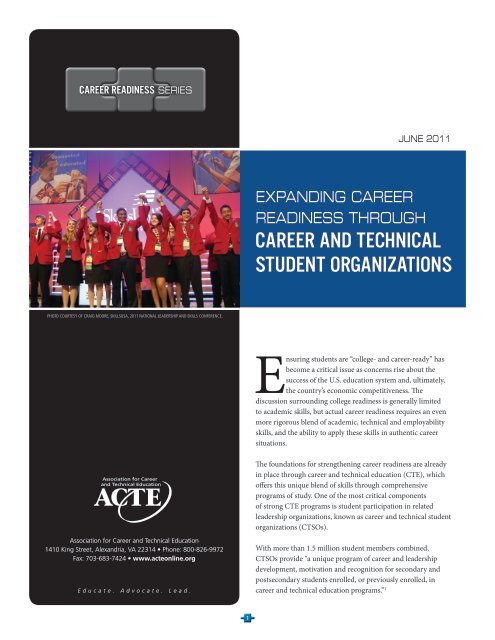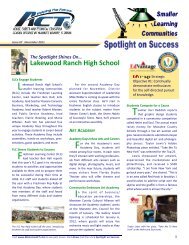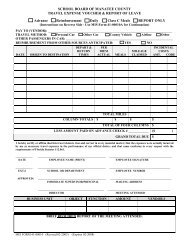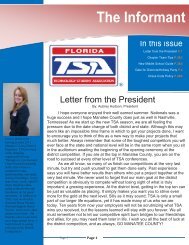readiness through career and technical student organizations
readiness through career and technical student organizations
readiness through career and technical student organizations
You also want an ePaper? Increase the reach of your titles
YUMPU automatically turns print PDFs into web optimized ePapers that Google loves.
EMPLOYABILITY SKILLSEmployability skills have often been cited by employers as theskills most critical to workplace success in the 21st-centuryeconomy. Many positive examples of these skills have beenidentified in CTSO programs, including teamwork, decisionmaking,critical thinking, leadership, community awareness,<strong>career</strong> awareness, <strong>and</strong> personal <strong>and</strong> social development.For example, FCCLA members have reported that <strong>career</strong>preparation, communication, <strong>and</strong> leadership were among thetop skills they developed <strong>through</strong> their involvement. 8Numerous research studies over the last several decades havealso shown that <strong>student</strong>s’ leadership skills in particular areincreased <strong>through</strong> participation in CTSOs. 9 BPA 2010-2011College/Postsecondary President Micah Hopper explained thatleadership is one of his biggest gains from participation. “BPAhas given me the opportunity to make a difference in people’slives by helping them grow as leaders. It has also given me theleadership experience that I was looking for to be a successfulbusiness owner.” 10TECHNICAL SKILLSThrough professional development activities <strong>and</strong> competitiveevents, <strong>student</strong>s participating in CTSOs can gain enhancedjob-specific knowledge <strong>and</strong> skills critical to future <strong>career</strong>s. Forexample, <strong>student</strong>s in FBLA develop competitive projects insuch areas as accounting, cybersecurity <strong>and</strong> marketing to gainin-depth skills in these areas, while <strong>student</strong>s in FEA compete inimpromptu speaking <strong>and</strong> lesson planning <strong>and</strong> delivery to honetheir <strong>career</strong> skills, <strong>and</strong> HOSA <strong>student</strong>s demonstrate knowledgeof medical terminology <strong>and</strong> medical <strong>career</strong>s, as well aslaboratory procedures in areas like biotechnology. These eventshelp <strong>student</strong>s transfer knowledge gained in the classroom toauthentic <strong>career</strong>-related situations.Another set of such events is the SkillsUSA Championships,where SkillsUSA <strong>student</strong>s showcase their skills. Thesecontests start at the local level <strong>and</strong> continue <strong>through</strong> the state<strong>and</strong> national levels. During the 2011 SkillsUSA NationalChampionships, more than 5,500 contestants competedin 94 separate events, which included such categories as3-D Visualization <strong>and</strong> Animation, Architectural Drafting,Automated Manufacturing Technology, Occupational Health<strong>and</strong> Safety, <strong>and</strong> Mobile Robotic Technology.The philosophy of the Championships is to “reward <strong>student</strong>sfor excellence, to involve industry in directly evaluating <strong>student</strong>performance <strong>and</strong> to keep training relevant to employers’needs.” 11 Students who demonstrate outst<strong>and</strong>ing achievement inthe <strong>technical</strong> competitions will be awarded Skill Point Certificatesvalidated by industry leaders. The certificates contain listsof competencies mastered <strong>and</strong> the logos of companies that plan<strong>and</strong> manage the competitions, <strong>and</strong> they serve as documentationof skills for <strong>student</strong>s to use with potential employers.Other opportunities both in <strong>and</strong> outside the classroom, suchas state <strong>and</strong> national conferences, contribute to <strong>student</strong>s’<strong>technical</strong> knowledge <strong>and</strong> expose them to business <strong>and</strong> industryopportunities <strong>and</strong> requirements. Recent research of <strong>student</strong>sin TSA showed that TSA activities contributed significantly to<strong>student</strong>s’ underst<strong>and</strong>ing of skills required for a <strong>technical</strong> <strong>career</strong>,such as knowledge of how technology works <strong>and</strong> of the designprocess. 12Like all CTSOs, FCCLA chapters across thecountry provide significant communitysupport <strong>through</strong> a number of diverse national programs <strong>and</strong>service projects that contribute to <strong>student</strong>s’ <strong>career</strong> <strong>readiness</strong>.For example, “FACTS—Families Acting for Community TrafficSafety” is a FCCLA peer-education program <strong>through</strong> whichyoung people strive to save lives <strong>through</strong> safe driving habits.Members from Brookings High School, South Dakota,positively affected their community <strong>and</strong> developedemployability skills by planning <strong>and</strong> carrying out a year-longproject that focused on safe driving. Their “Drive to Survive”project enabled the <strong>student</strong>s to advocate on traffic safetyissues, influence their peers on the school campus, promotetheir efforts to the community <strong>and</strong> collaborate with variouscommunity stakeholders—all skills that will help them asthey pursue further education <strong>and</strong> <strong>career</strong>s. Specific projectactivities planned <strong>and</strong> conducted by <strong>student</strong>s included adocudrama, DUI simulations, school assemblies <strong>and</strong> displays,<strong>and</strong> workshops on distracted driving. Students enhancedtheir communication skills <strong>through</strong> the development ofpublic service announcements, newspaper articles <strong>and</strong>interviews with local radio <strong>and</strong> TV stations. One of the<strong>student</strong> members even had the opportunity to testify beforelegislators on texting-<strong>and</strong>-driving bills in the state capitol <strong>and</strong>Washington, DC.3
As in other CTSOs, FFA’s local, state<strong>and</strong> national leadership conferencesprepare <strong>student</strong>s to be leaders in their schools, jobs <strong>and</strong>communities. Students hone their leadership skills bygiving speeches, participating in debates, organizingceremonies <strong>and</strong> events <strong>and</strong> conducting community serviceprojects. A special FFA-developed curriculum known asLifeKnowledge, which includes lesson plans, activities <strong>and</strong>e-learning modules, helps FFA advisers integrate leadership,personal growth <strong>and</strong> <strong>career</strong> success instruction into theirclassrooms, benefitting all <strong>student</strong>s. Content includes suchdiverse topics as conflict management, strategic thinking,personal goal setting <strong>and</strong> business communications.FFA 2010-2011 President Riley Pagett elaborated furtheron the leadership skills gained in FFA. “My membership inFFA has allowed me to develop real, tangible leadership—looking others in the eye when spoken to, shaking h<strong>and</strong>sfirmly, holding the door open <strong>and</strong> practicing manners,recognizing the potential of others <strong>and</strong> drawing on thatpotential, delegating work, using time efficiently, allowingothers to occasionally take the lead, speaking confidently,remaining flexible, respecting others, remembering thepast, making wise decisions, overcoming obstacles <strong>and</strong>rising to the call of action when others need you to reallyserve them.” 13EDUCATIONAL ATTAINMENTIn addition to providing enhanced academic, employability<strong>and</strong> <strong>technical</strong> skills, CTSOs also have an impact on <strong>student</strong>s’educational attainment. The vitality <strong>and</strong> competitiveness ofAmerica’s economy are contingent upon increasing the numberof high school <strong>and</strong> college graduates, <strong>and</strong> more <strong>student</strong>sneed education <strong>and</strong> skills beyond high school for true <strong>career</strong><strong>readiness</strong>.• According to the National Research Center for Career<strong>and</strong> Technical Education, participating in leadership <strong>and</strong>professional development activities in a CTSO raises<strong>student</strong>s’ educational aspirations. 14• FFA members are preparing for postsecondary studies inslightly higher numbers <strong>and</strong> have more sharply defined<strong>career</strong> objectives than the average <strong>student</strong>. 15• According to TSA, of their 150,000 middle <strong>and</strong> highschool <strong>student</strong> members, 100 percent are likely to graduatefrom high school <strong>and</strong> 75 percent are college-bound. 16• More than 30 percent of <strong>student</strong>s in BPA are also enrolledin AP courses, above the 2010 national average of 28.3percent, <strong>and</strong> 30 percent are involved in dual enrollment,as well. 17• More than 70 percent of DECA members at the 2009International Career Development Conference indicatedthat DECA has influenced their future <strong>career</strong> plans, <strong>and</strong>more than 65 percent indicated that DECA has influencedtheir future college plans. 18References1 Fiscus, L. (Ed.), Career <strong>and</strong> Technical Student Organizations:A Reference Guide (National Coordinating Council for Career<strong>and</strong> Technical Student Organizations, 2008): p. 3.2 Alfeld, C., Stone, J. R., Aragon, S. R., Hansen, D. M., Zirkle, C.,Connors, J., et al., Looking Inside the Black Box: The Value Added byCareer <strong>and</strong> Technical Student Organizations to Students’ High SchoolExperience (St. Paul, MN: National Research Center for Career <strong>and</strong>Technical Education, University of Minnesota, 2007).3 Eccles, J., & Barber, B., “Student Council, Volunteering, Basketball, orMarching-b<strong>and</strong>: What Kind of Extracurricular Involvement Matters?”Journal of Adolescent Research 14, no. 1 (1999).4 Zirkle, C., & Connors, J. J., “The Contribution of Career <strong>and</strong> TechnicalStudent Organizations to the Development <strong>and</strong> Assessment ofWorkplace Skills <strong>and</strong> Knowledge: A Literature Review,” WorkforceEducation Forum 30, no. 2 (2003).5 SchoolMatch®, FBLA Student Evaluation Study—2008.6 Balschweid, M. A., & Talbert, B. A., A Comparison of AgriculturalEducation Students to the `Typical High School Student’ as Quantified inThe State of Our Nation’s Youth: By the Horatio Alger Association (WestLafayette, IN: Purdue University, 2000).7 National Research Center for College <strong>and</strong> University Admissions,DECA: 2010 Annual Report.8 National Research Center for College <strong>and</strong> University Admissions,FCCLA: 2011 Annual Report.9 Alfeld, C., et al., Looking Inside the Black Box: The Value Added byCareer <strong>and</strong> Technical Student Organizations to Students’ High SchoolExperience.10 Reese, S., “Creating the Leaders of Tomorrow Today,” Techniques86, no. 5 (May 2011): p. 1711 SkillsUSA, “SkillsUSA Championships,” www.skillsusa.org/compete/skills.shtml.12 Taylor, J. S., “Student Perceptions of Selected Technology StudentAssociation Activities,” Journal of Technology Education 17, no. 2(2006).13 Reese, S., “Creating the Leaders of Tomorrow Today,” p. 18-19.14 Alfeld, C., et al., Looking Inside the Black Box: The Value Added byCareer <strong>and</strong> Technical Student Organizations to Students’ High SchoolExperience.15 Balschweid, M. A., & Talbert, B. A., A Comparison of AgriculturalEducation Students to the `Typical High School Student’ as Quantifiedin The State of Our Nation’s Youth: By the Horatio Alger Association.16 Technology Student Association, “TSA Facts,” www.tsaweb.org/TSA-Facts.17 National Research Center for College <strong>and</strong> University Admissions,BPA: 2011 Annual Report.18 DECA, Inc., “College <strong>and</strong> Career Ready,” www.deca.org/ready/.4






